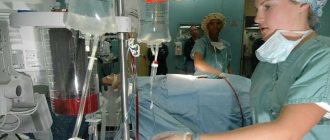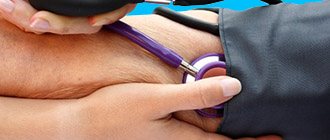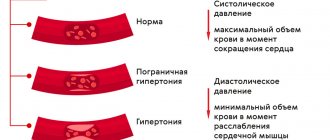The structure of the eye has a complex structure, but it is not necessary to study it all in detail to understand what intraocular pressure is and why it suddenly deviates from the norm. It is enough to imagine the eye as a liquid surrounded by multiple membranes. The outer one is the sclera, behind it is a network of blood vessels, and even deeper is the ciliary body. When the muscles contract, the shape of the lens changes and the person can see something up close. But this is not the only function of the ciliary body.
Another important task assigned to it is the secretion of intraocular fluid. By circulating between the various chambers of the eye, it ensures normal metabolism and maintains a certain level of intraocular pressure (IOP). In other words, the fluid secreted by the ciliary body constantly puts pressure on the eye, setting the parameters of its normal size and shape. As soon as the amount of this fluid increases excessively or there are problems with its outflow, the pressure will jump. This will entail distortion of the shape, and, consequently, of the entire optical system of the eye.
Important! Intraocular pressure directly affects the quality and acuity of vision. When it deviates from the norm, the shape of the eyeball changes and the mechanisms of accommodation that allow close vision are disrupted.
Iphthalmotonus standard
The constant accepted norm of pressure inside the eyes in an adult lies in the range from 10 to 22 mm Hg. Art. (on average, for most people these indicators are 15-17) and is characterized by constancy. During one day, the pressure fluctuates only within 3-4 mmHg. Art. — in the morning it is usually higher, decreasing slightly in the evening. Consistency is necessary for the stable functioning of the inner membranes of the eye, especially the retina, and depends on a number of physiological mechanisms responsible for regulating the filling of the vessels inside the eye with blood, the influx and outflow of aqueous humor. In addition, normal ophthalmotonus is important for maintaining the optical properties of the retina.
Cost of services for glaucoma
| № | Service name | Price in rubles | Make an appointment |
| 2010025 | Set of disposable consumables for antiglaucomatous surgery | 36000 | Sign up |
| 2010024 | Molteno valve implantation | 54000 | Sign up |
| 2010023 | Implantation of the EX-Pres shunt valve | 54000 | Sign up |
| 2010022 | Ahmed valve implantation | 54000 | Sign up |
| 2010021 | Summing collagen or silicone drainage | 9000 | Sign up |
| 2010020 | Pupilloplasty | 30000 | Sign up |
| 2010019 | Iridoplasty | 22200 | Sign up |
| 2010018 | Basal iridotomy | 10800 | Sign up |
| 2010001 | Sinutrabeculectomy (STE) | 42000 | Sign up |
| 2010002 | Non-penetrating deep sclerectomy (NPDS) | 46200 | Sign up |
| 2010004 | Antiglaucomatous surgery for primary glaucoma of the first category of complexity | 23400 | Sign up |
| 2010005 | Antiglaucomatous surgery for primary glaucoma of the second category of complexity | 30600 | Sign up |
| 2010006 | Antiglaucomatous surgery for primary glaucoma of the third category of complexity | 37200 | Sign up |
| 2010007 | Antiglaucomatous surgery for secondary or refractory glaucoma of the first category of complexity | 29500 | Sign up |
| 2010008 | Antiglaucomatous surgery for secondary or refractory glaucoma of the second category of complexity | 42000 | Sign up |
| 2010009 | Antiglaucomatous surgery for secondary or refractory glaucoma of the third category of complexity | 48000 | Sign up |
| 2010010 | Antiglaucomatous surgery with drainage of the anterior chamber angle for primary glaucoma of the first category of complexity | 28200 | Sign up |
| 2010011 | Antiglaucomatous surgery with drainage of the anterior chamber angle for primary glaucoma of the second category of complexity | 39300 | Sign up |
| 2010012 | Antiglaucomatous surgery with drainage of the anterior chamber angle for primary glaucoma of the third category of complexity | 45600 | Sign up |
| 2010013 | Antiglaucomatous surgery with drainage of the anterior chamber angle for secondary or refractory glaucoma of the first category of complexity | 33360 | Sign up |
| 2010014 | Antiglaucomatous surgery with drainage of the anterior chamber angle for secondary or refractory glaucoma of the second category of complexity | 43800 | Sign up |
| 2010015 | Antiglaucomatous surgery with drainage of the anterior chamber angle for secondary or refractory glaucoma of the third category of complexity | 54000 | Sign up |
| 2010017 | Reconstruction of the anterior chamber angle in secondary glaucoma | 27000 | Sign up |
Making an appointment Today registered: 21
What pressure values indicate the presence of pathology?
In a situation where IOP has elevated values, this is a sign to sound the alarm, since its increase indicates the presence of glaucoma at different stages. Here is a table from which you can find out how dangerous you are from this disease 1. A value from 10 to 22 mm Hg is considered normal. Art. (usually 15-17). 2. A pressure of 22 to 25 mmHg may indicate primary signs of glaucoma, in which case a thorough examination should be performed. 3. The figure 25-27 mmHg most likely confirms the presence of the initial stage of glaucoma. 4. When the ophthalmotonus level is 27-30 units, we can say that glaucoma is actively developing. 5. IOP value is above 30 mm Hg. Art. means a severe degree of development of the disease.
We remind you that the change in pressure inside the eyes during the day should not exceed the norm of 3-4 mm Hg. Art. - higher in the morning, lower in the evening. What factors may prompt you to contact a specialist to check your eye pressure?
What to do to reduce blood pressure?
People suffering from ocular hypertension are interested in how to reduce eye pressure. Special drops best cope with this task, but they must be prescribed by an ophthalmologist. If it is not possible to see a doctor in the near future, then reduced with the help of a tincture of sleep grass, wild pear shoots and nettle. A decoction prepared from these herbs should be taken three times a day before meals.
Doctors also recommend instilling a solution made from onion juice and good honey into the eyes.
Symptoms indicating the presence of elevated IOP
So, doctors advise paying attention to the following phenomena, which may indicate increased ophthalmotonus. People who already have relatives with glaucoma in their family should be especially attentive to eye health:
- pain in the temples and above the eyebrows when raising the eyes upward, especially in the evening;
- frequent headaches and the inability to get rid of them even with the help of medications;
- burst blood vessels on the white of the eye;
- severe eye fatigue in the evening, discomfort when looking up or to the sides;
- blurred vision after a night's sleep, when it takes time for it to return to normal;
- rapid eye fatigue during visual work;
- decreased clear visibility when moving from a bright room to a darker one.
Here are the main symptoms of so-called eye hypertension, which doctors advise you to pay attention to, especially if you are predisposed to glaucoma. If they recur regularly, then this is a reason to contact a specialist for a thorough examination of the visual organs.
How to maintain normal ophthalmotonus
To avoid long-term treatment with medications and not lead to surgical intervention, you need to follow simple rules for the prevention of increased ophthalmotonus:
- sleep at least 8 hours a day and avoid stressful situations;
- if there is no need, do not spend a long time in front of a computer monitor;
- work in good lighting to reduce eye strain;
- do not wear clothes with tight collars and buttons to ensure normal blood flow in the cervical-collar area;
- eat right, limiting the amount of salt in dishes, avoiding fried, spicy and smoked foods;
- drink 1.5 liters of clean water per day;
- Raise the pillow during night sleep to ensure proper drainage of aqueous fluid from the eye.
It has been established that bad habits (drinking alcohol and smoking) contribute to pathological narrowing of blood vessels.
As a result, the blood supply to internal organs, the brain and the organs of vision deteriorates. Otherwise, it is fraught with the development of hypertension, other systemic diseases and increased ophthalmotonus. Therefore, if you are prone to eye pressure, it is better to make a choice in favor of a healthy lifestyle.
It must be remembered that normal eye pressure is different for everyone, but it is necessary to adhere to generally accepted standards. If you notice symptoms such as eye fatigue, redness and dryness of the apples, migraine-type headaches, deterioration of visual function, you should immediately visit an ophthalmologist. This will allow you to start treatment on time, if necessary, and reduce the risk of developing glaucoma.
Risk factors that may cause increased IOP
Increased pressure inside the eyeball can also be caused by some common human diseases. That is why the doctor collects in detail all the data about your lifestyle, hereditary diseases, and even what activities you like to do in order to accurately establish the clinical picture. For example, an increase in ophthalmotonus can provoke disturbances in the functioning of internal systems or organs.
1. Diabetes mellitus. This is a group of endocrine diseases characterized by increased blood sugar, as well as the inability of the pancreas to produce the hormone insulin. The body experiences constant jumps in sugar from normal levels to high or, conversely, low. In this regard, problems begin with the condition of the blood vessels, causing an increase in arterial and intraocular pressure. 2. Vegetovascular dystonia. Persons suffering from VSD may complain of interruptions in heart function, decreases or surges in blood pressure, as well as headaches and dizziness. At the same time, the functioning of many body systems is disrupted. VSD can also cause an increase in ophthalmotonus. 3. Diseases of the cardiovascular system. Their list is quite extensive. These may be atherosclerosis, congenital heart disease, impaired elasticity of blood vessels, varicose veins and many other ailments affecting the normal functioning of the heart and blood vessels. 4. Kidney diseases. Severe and long-term glomerulonephritis, as well as a wrinkled kidney, can lead to retinal lesions and increased eye pressure. 5. The presence of uveitis, astigmatism, farsightedness and some other disorders can also cause an increase in IOP. 6. Post-traumatic glaucoma. Occurs after mechanical or chemical damage to the organs of vision. 7. Spending a long time in front of a computer monitor. Research by scientists has long confirmed the fact that prolonged exposure to a screen and intense visual work can provoke an increase in ophthalmotonus. The eyes are under constant tension, the person begins to blink several times less often, a headache may occur and the IOP may increase.
We have listed several factors that can cause increased intraocular pressure. In addition, people over 40 years of age are at risk, since the older the age, the more common the disease. However, increased eye pressure can also occur in children, so parents should be vigilant. If he has any visual impairments (myopia, astigmatism, lazy eye syndrome, etc.), then this is a reason to keep eye pressure readings in children under control.
Symptoms of "pressure in the eye"
Significant discomfort in the eye area can be caused by conditions not associated with increased intraocular pressure. Fullness and pain in the eyeballs accompanies a number of common diseases (migraine, hypertension, hypotension, cold viral diseases, bronchitis and other diseases accompanied by cough). Heaviness and swelling of the eyes can also be caused by eye diseases (conjunctivitis, optic neuritis, iridocyclines, keratitis, etc.).
In the modern world of computer technology, office workers, students and schoolchildren increasingly complain about pain, heaviness and swelling in the eyes. Chronic overstrain and visual fatigue in people of such professions, associated with sitting in front of a monitor, even got its name - “computer vision syndrome.”
Whatever the reasons for the feeling of fullness in the eyeball and increased IOP, none of them is absolutely safe. Any discomfort in the organs of vision signals the need to rest the eyes and switch to other activities. If fatigue becomes permanent, it is necessary to undergo an examination by an ophthalmologist, since in most cases the preservation of vision directly depends on the stage at which treatment was started.
How is eye pressure measured?
At home, the patient can use only one method available to him - palpating the eyeball through the eyelids, determining by touch the degree of its density. If the pressure is normal, then with gentle pressure you should feel a moderately elastic round ball under your fingers. With an increased IOP, it will be quite hard and not prone to deformation, but with a decreased IOP, on the contrary, it will sag. Of course, this method does not give correct readings and can only be used to understand the approximate condition, although people suffering from elevated IOP acquire the necessary skills over time. The exact data can be found in the doctor’s office, where he will conduct an examination using special instruments and also examine your fundus.
Tonometric measurement method. This is done using a tonometer. There are several types of them, but the most famous and common are Maklakov tonometer and Goldman tonometer. We will not go into technical details and a description of the measurement procedure, the only important thing is that these methods will help determine the exact intraocular pressure. Non-contact blood pressure monitors. Sophisticated electronic devices that are used more and more often today, as this method gives even more accurate readings. If, with the help of the first two tonometers, a direct effect is made on the eye, drugs are used to anesthetize the cornea, since there is a physical effect on the organ of vision, then with the help of a non-contact tonometer, measurements are carried out using a stream of air directed at the cornea.
How to relieve intraocular pressure?
Trying to deal with the consequences without eliminating the cause is useless. That is why, if you notice that your eyes are constantly tired, red and very tense, you need to look for a reason that provokes periodic jumps in intraocular pressure. Further, the method of eye restoration will depend on how neglected everything is.
If we are talking about the initial stages and barely noticeable symptoms, then, most likely, preventive measures alone will be sufficient:
- master a set of eye exercises and devote a few minutes a day to it;
- choose safety glasses for reading and standing in front of a monitor;
- As far as possible, limit any eye strain - TV, computer, working with small parts;
- give up contact and strength sports;
- Spend free time outdoors, giving your eyes a chance to rest and look into the distance.
Treatment of intraocular pressure with drops
When high IOP ceases to be episodic and develops into ocular hypertension or hypotension, preventive measures alone are not enough - timely local treatment is needed. With such diagnoses, the easiest way to regulate the pressure in the eye is with eye drops. They come in several types.
- Those that act directly on the ciliary body and reduce fluid production are carbonic anhydrase inhibitors. The most popular of this group are Azopt and Trusopt. By reducing the amount of intraocular fluid, the pressure also decreases, but this process can be accompanied by burning, severe redness of the eyes and even a bitter taste in the mouth.
- The second category is prostaglandins. They operate on a different principle: they affect not the amount of fluid, but its intensive outflow.
- Beta blockers. They also reduce the amount of fluid formed in the eye, but have one significant nuance - together with eye pressure, they reduce the heart rate, which is strictly contraindicated for heart patients.
There are also combination drugs that act in two directions: on the one hand, they inhibit the process of fluid production, and on the other, they increase its outflow.
Important! On average, drops are used twice a day, but the exact dosage and frequency of instillation can only be determined by a doctor, having an accurate description of the clinical picture. By self-medicating, you can not only further damage your vision, but also damage your cardiovascular system, lungs and kidneys.
Relieving intraocular pressure at home
If you feel pressure in your eyes, but cannot immediately get an appointment with an ophthalmologist, then instead of drops you can try to relieve painful symptoms using traditional methods. Helps normalize eye pressure:
- meadow clover decoction (brew with boiling water, leave for 2 hours and drink 100 g before bedtime);
- tincture of golden mustache (pour about 20 purple inflorescences with 500 grams of vodka and leave in a dark place for 12 days, then take one teaspoon before breakfast);
- a glass of kefir with cinnamon.
No matter how tempting such treatment may seem, ophthalmologists do not recommend relying too much on it. Such recipes can be used only if the pressure jumps rarely and not greatly. Trying to get rid of serious symptoms that indicate progressive blindness in this way is simply dangerous.
Most of these arrogant patients, when they finally get to the ophthalmologist’s office, hear one thing: “an operation is necessary.” A laser is used to relieve high intraocular pressure. Depending on where the problem is located, they can either excise the iris or stretch the trabecula to increase the flow of fluid.
If you don't want to end up in the operating room, take the advice of ophthalmologists seriously and constantly engage in prevention. A five-minute break every hour of working near the computer, a simple set of gymnastic exercises for the eyes, a dinner of sea fish and blueberry-carrot snacks - and you will maintain sharp vision for many years!
What other consequences can occur with high blood pressure?
In most cases, an increase in IOP leads specifically to glaucoma, but there are cases when it also provokes the following disorders:
- Retinal detachment is the process of separation of the retina from the choroid. In a healthy eye they are in close contact. As a result of retinal detachment, a noticeable decrease in the quality of vision occurs;
- Optic neuropathy is the partial or complete destruction of the nerve fibers that are responsible for transmitting images to the brain. This can lead to distorted color vision.
These two eye disorders, along with glaucoma, if untimely intervention lead to blindness in almost 100% of cases. This is why it is so important to monitor the pressure inside the eyes, especially after the age of 40.
Why does blood pressure deviate from the norm and how to restore it?
Even healthy people who do not suffer from attacks of hypertension do not always have normal intraocular pressure. An increase can occur as a result of chronic eye fatigue, after working at a computer for a long time or watching television. Pathological causes of changes in IOP indicators include:
- increased production of aqueous fluid and disruption of its outflow due to chronic diseases;
- pathologies of the heart and blood vessels, due to which blood pressure increases, and subsequently intraocular pressure;
- regular stressful situations, due to which large amounts of adrenaline are released into the blood;
- inability of capillaries to independently regulate tone;
- anatomically incorrect congenital eye structure;
- hereditary predisposition.
To normalize the pressure inside the eyes and prevent the risk of developing glaucoma, it is necessary to limit the time spent in front of the TV and computer. If you need to do computer work every hour, it is recommended to do eye exercises. Patients who are overweight, suffering from arterial hypertension and with the initial stage of atherosclerosis must follow a diet and take medications prescribed by a doctor.
These are beta blockers, ACE inhibitors, diuretics, calcium channel blockers and other medications. All patients with hypertension and increased intraocular pressure are advised to take walks in the fresh air, moderate physical activity and regular examinations by a doctor.
Treatment of high eye pressure
Today, the most common and accessible way to reduce increased ophthalmotonus is the use of special drops that normalize it. But it is also necessary to take into account the reasons that provoked the increase in IOP, and, if possible, eliminate or treat them. In addition to drops, there are also several other methods of combating high eye pressure. An ophthalmologist can prescribe physiotherapeutic procedures (vacuum massage, color pulse therapy, etc.), which are carried out in a hospital setting.
The most drastic way to normalize blood pressure is surgery. There are also several types of them: goniotomy, trabeculectomy and the most advanced method - laser surgery. With the help of a laser beam, the outflow pathways of intraocular fluid are opened, as a result of which the ophthalmotonus decreases. But, unfortunately, in order to undergo the operation, the patient must meet certain requirements, and not everyone fits them. In any case, the treatment method is selected individually depending on age, severity of the disease, and individual characteristics of the body.
Additional Treatments
Even the most innovative drops for reducing eye pressure work best only in combination with a healthy lifestyle and eye exercises. Also, do not forget about some simple, but at the same time effective rules that will help stabilize vision and prevent the progression of the disease. Ophthalmologists strongly recommend watching TV or working at a computer for no more than two hours at a time, and then doing gymnastic exercises and giving your eyes a rest. Limit consumption of salt, coffee, energy drinks and strong teas, as well as alcohol. Additionally, if you have been diagnosed with chronic eye pressure, it is not recommended to lift heavy objects, as this can cause damage to the optic nerve. Experts, in addition, advise sleeping on a volumetric pillow - this way the head will be higher than the level of the body, which, in turn, will help to avoid increased pressure. You should use the drops strictly according to the instructions and constantly visit a specialist to monitor the disease.
Preventing ocular high pressure
What to do if you are at risk? First of all, adjust your diet, thus promoting IOP stability. It is necessary to minimize the consumption of salt, sugar, fast carbohydrates and include the following foods in the daily diet: dark chocolate, nuts, eggs, red vegetables and fruits. It is also necessary to maintain a sufficient amount of vitamins E, ascorbic acid and beta-carotene in the body.
In addition to nutrition, you also need to follow simple recommendations from doctors, adhering to a healthy lifestyle: spend more time in the fresh air, give up smoking and alcohol, do not eat foods containing high amounts of cholesterol, do not spend long periods of time looking at gadgets and computer screens, and do special exercises for eyes. The eyes are our window to the world; with their help, a person perceives up to 90% of the surrounding information, which is why it is important to maintain their health in order until old age. If you experience discomfort in your eyes, you should not hesitate and make an appointment with a doctor. We wish you good health and good vision!
Prevention of relapse
Before re-treating ophthalmotonus disorders, you need to try simple preventive measures to ensure the maintenance of lasting results of the therapy received:
- do not take breaks in the use of medications if the doctor has prescribed their instillation on an ongoing basis;
- avoid stress, get proper rest, do not overload the nervous system;
- be in more light so as not to provoke dilation of the pupils and an increase in intraocular pressure;
- follow a diet with limited salt, fried, smoked and spicy foods;
- stop smoking, alcohol and caffeinated drinks;
- drink at least 1.5-2 liters of clean water per day.
Patients prone to changes in ophthalmotonus are recommended to take blueberry-based vitamin preparations for the eyes and include more carrots and fish in their diet. When working at a computer, every hour you need to pause and perform a series of gymnastic exercises for the eyes. Once a year it is necessary to visit an ophthalmologist to monitor the condition of the retina, vision and ophthalmotonus.
Dangerous consequences of increased pressure in the eyes include the development of glaucoma and complete blindness, so you should not consider ocular hypertension a non-serious disease. If regular signs of problems with IOP appear (redness and fatigue of the eyes, dry mucous membranes, loss of luster and blurred vision), you should consult a specialist.
At the initial stages of the pathology, medications, exercises and measures to prevent relapse will help relieve symptoms. And with advanced forms of the disease, surgical intervention is no longer possible. Therefore, if you have eye diseases, it is better to visit a doctor again than to develop glaucoma and lose your vision.
And yet, what factors can affect IOP?
Eye fatigue. Vision is a passive process. It doesn't matter if you spend most of your day staring at a computer screen, constantly knitting, or working as a seamstress. Fatigue is manifested by dry eyes - they may begin to water, itch, turn red, “burn”, “prick”, etc. This is due to the fact that those looking at the seam or monitor blink less often. Instead of the norm 10-15 times per minute - only 5-6 times.
It turns out that to avoid the harmful effects of fatigue, all you need to do is blink more often?
Of course, but it is important not to “skip” visiting the doctor. We never tire of reminding you: the patient’s chances in diagnosis, treatment and results are limited by the doctor’s capabilities – his level of education, experience and class of equipment. And there is only one place where we have collected all the newest and best... just kidding, of course, but one of these places is the Vasily Shevchik Clinic, where your vision will be taken seriously.










